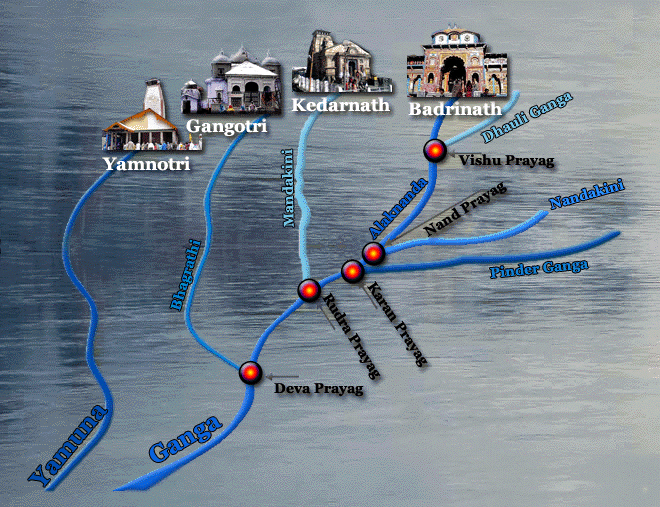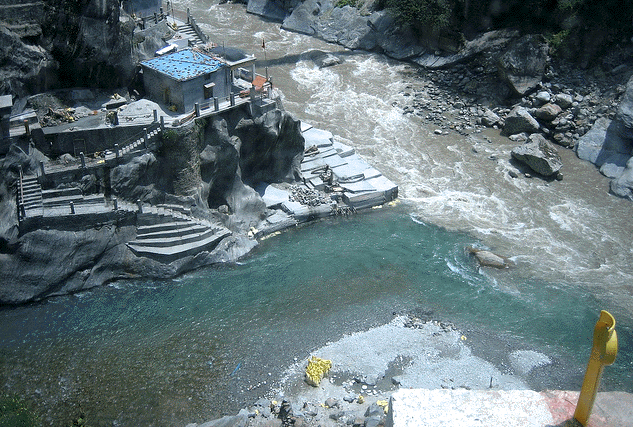
|
|
|
|
BY: SUN STAFF

The Pancha-prayag Jun 4, 2019 — CANADA (SUN) — A serial presentation of the holy places mentioned in the Jaiva Dharma of Srila Bhaktivinoda Thakur - Part 5.
The Alakananda River mentioned in Srila Bhaktivinoda Thakur's Place Names glossary in Jaiva Dharma is one of five sacred rivers flowing down from the Char-dham. Known collectively as the Pancha-prayag, they include the Yamuna, Ganga, Bhagirathi, Mandakini, and Alaknanda rivers.
The Alaknanda River originates on the eastern slopes of the Himalayan glacier fields at Chaukhamba. It descends from the foot of the Satopanth, a triangular lake located at nearly 15,000 feet above sea level. Satopanth is named for the Trimurti: Lord Brahma, Lord Vishnu and Lord Shiva, who come to this place to take holy bath. The waters are kept clean by local birds who remove pollutants from the lake. They are said to be Gandharvas in disguise, guarding the waters of Satopanth.
First, the Alakananda is joined by the Saraswathi River, which originates on the south from the international border. This confluence is near Mana-Badarinath, at Kesava-prayag. From here the co-joined waters continue to take the name Alakananda.
ALAKANANDA AT BADRINATH DHAM

Badrinath-dham on the Alakananda The river flows in front of the Badrinath Temple, one of the most revered Char-dham shrines. Badrinath-dham is situated in a valley of the Nara-Narayan Parvat, part of the lower Himalayan chain. The temple stands facing the Alakananda, with Neelkanth, an imposing Himalayan peak rising 21,000 feet in the background. Badrinath dham itself sits at approximately 10,350 ft. 
The Alakanandaat Vishnu-Prayag - the confluence of Alaknanda and Dhauliganga ALAKANANDA AT VISHNU-PRAYAG From Badrinath, the Alakananda goes on to meet the Dhauli Ganges River, whose origin is around Niti Pass, after it travels a distance of 25 km (15.5 mi) from its source to form the Vishnu Prayag. Vishnu Prayag is situated 10 km past Joshimath, on the Joshimath–Badrinath road, at an elevation of 1372 meters above sea level. Although Vishnu Prayag is the smallest of the five prayags, this confluence is quite breathtaking. The waters of Alaknanda and Dhauliganga meet at a very high speed here at Vishnuprayag, giving pilgrims a terrific view of the potency of these sacred rivers. The great sage Narada came to worship Lord Vishnu at this prayag, and there is a small Rishi Narada temple here at the sangam. Sage Narada performed austerities here for many years, and is said to have ascended from this holy Vishnuprayag. The Pandava brothers are also said to have passed through Vishnuprayag while enroute to the deep Himalayas. Read more about Visnu-Prayag 
Nandaprayag: Confluence of the Nandakini and Alaknanda Rivers ALAKANANDA AT NAND-PRAYAG Next, the Alakananda meets the Nandakini River, and this confluence is known as the Nand Prayag. Nanda Prayag is the second prayag in the cascade sequence of confluences coming down from the Garhwal Himalayas. This prayag is the point where the Alaknanda, which at this point also embodies both the Saraswati and Dhauli-ganga, joins up with the sacred Nandakini River. The confluence gets its name from the Yadava king Nanda, the foster-father of Sri Krishna, and there is a temple of Gopal Krishna here. Nanda Maharaja is said to have performed a great sacrifice at this spot. Read more about Nanda-Prayag 
The Alaknanda River flowing in from the left meets the Pindar River (center background) ALAKANANDA AT KARNA-PRAYAG Next, the Alakananda meets the Pindar River, which flows down from the Pindar glacier. The confluence of these two rivers is the Karna Prayag. Karnaprayag is located at an elevation of 1,451 meters (4,760 feet) above sea level. The main tributary of the confluence originates at Pindar Glacier, below the Nanda Devi hill range, and it's also fed by the Milam Glacier, another of the Nanda Devi group. Nanda Devi mountain towers to a height of 7,816 m. (25,634 ft.), and is surrounded by the icy peaks of Trisul, Drona Giri, Narad Ghunti, Mrigathuni and Maiktoli hills.
The Puranas state that when Karna came to this place, there was no river confluence, so the spot was not entirely fitting for his performance of tapasya. Thus Karna caused the Pinder River to descend and meet the Alaknanda here.
Read more about Karna-Prayag

Rudraprayag, at the confluence of the Alaknanda (foreground) and Mandakini Rivers ALAKANANDA AT RUDRA-PRAYAG Next, meets the Mandakini at the Rudra Prayag coming down from Kedernath-dham. While Badrinath is the source of holy waters for the first three prayags of the Panch Prayag, Rudraprayag is associated with Kedernath-dhama, from which the Mandakini River proceeds. After merging with the Mandakini, the Alaknanda River flows on towards Devaprayag where it joins with Bhagirathi river to form the Ganges. Kedarnath is 86 km. north of Rudraprayag. The Rudraprayag confluence of the Alaknanda and Mandakini Rivers is named after Lord Shiva, in his Rudra manifestation. Shiva is said to have performed Tandava here, the vigorous dance of Nataraj. He also played his Rudra veena at this prayag, enticing Lord Visnu to come, then transforming Him into water. Read more about Rudra-Prayag 
The Bhagirathi (left joins the Alaknanda (right) at Devprayag ALAKANANDA AT DEVA-PRAYAG The Alakananda flows on until it meets the holy Bhagarathi at Deva Prayag. The Bhagarathi is coming down from Gangotri-dham. Devprayag is the southernmost, andtherefore the last of the five sacred river confluences of the Panchaprayag. Situated at an elevation of 830 metres (2,723 feet) above sea level, Devprayag is 70 km from Rishikesh. And while many tourists visit Rishikesh and Haridwar, relatively few take darshan of Devprayag. The Bhagirathi coming down from Gangotri-dhama is considered the foremost stream of the Ganges. Like all five of the Panch Prayag, he holiness of this place is considered equal to Triveni Sangam at Allahabad where the Ganges, Yamuna and Saraswati Rivers merge. At this confluence, the Bhagirathi flows in rapids with strong currents meeting a much calmer Alaknanda River, which is slower and more sediment-laden. At Devprayag there is a Brahma Kund on the Alakananda. Read more about Deva-Prayag From this point on, the Alakananda is known as the Ganga, and it runs parallel to the Yamuna, coming down from Yamunotri-dham. Considering the vast number of transcendental attributes of the Alakananda, we not only understand why Srila Bhaktivinoda included it in the Jaiva Dharma glossary, but also how sacred the many other tirthas on that list are, being in association with this jewel-like river, Alakananda.
| |